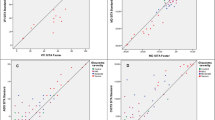Abstract
Purpose
To compare the clinical utilities of the SITA-based central 24–2 and 30–2 threshold tests.
Methods
Three hundred sixty-five (365) eyes of 183 glaucoma and glaucoma suspect patients who had undergone both central 30–2 and 24–2 threshold testing using the Swedish interactive threshold algorithm (SITA) standard strategy were retrospectively reviewed. The tests were performed in patients with a minimum visual acuity of LogMAR best-corrected visual acuity (BCVA) 0.3. We compared test time, fixation loss (%), false-positive error rate (%), and false-negative error rate (%), all of which are indices of reliability. We additionally compared the mean deviation (MD), pattern standard deviation (PSD), and visual field index (VFI), all of which are indices of the visual field test.
Results
The mean age was 54.67 ± 14.95. MD, VFI, and fixation loss showed no significant difference between the 30–2 and 24–2 tests. As expected, 24–2 was shorter in duration: 5.64 ± 1.09 min versus 7.51 ± 1.38 min (p < .001), a 24.51 ± 9.45% difference. The false-positive error rate was significantly higher, but the false-negative error rate was lower, with the 24–2 threshold test (p = .009, p < .001). The PSD also was lower with 24–2 than with 30–2 (p < .001).
Conclusion
The two tests’ VFI and MD are comparable. The 24–2 test may be a more efficient examination for most patients in terms of test time. In the other relevant aspects, the two tests are not identical. Therefore, it would be advisable to tailor visual field testing to the individual patient.

Similar content being viewed by others
References
Quigley HA, Broman AT (2006) The number of people with glaucoma worldwide in 2010 and 2020. Br J Ophthalmol 90:262–267
Bengtsson B, Heijl A (1998) Evaluation of a new perimetric threshold strategy, SITA, in patients with manifest and suspect glaucoma. Acta Ophthalmol Scand 76:268–272
Bengtsson B, Heijl A, Olsson J (1998) Evaluation of a new threshold visual field strategy, SITA, in normal subjects. Swedish Interactive Thresholding Algorithm. Acta Ophthalmol Scand. 76:165–169
Wild JM, Pacey IE, Hancock SA, Cunliffe IA (1999) Between-algorithm, between-individual differences in normal perimetric sensitivity: full threshold, FASTPAC, and SITA. Invest Ophthalmol Vis Sci 40:1152–1161
Wild JM, Pacey IE, O’Neill EC, Cunliffe IA (1999) The SITA perimetric threshold algorithms in glaucoma. Invest Ophthalmol Vis Sci 40:1998–2009
Bengtsson B, Olsson J, Heijl A, Rootzén H (1997) A new generation of algorithms for computerized threshold perimetry. SITA Acta Ophthalmol Scand 75:368–375
Wang Y, Henson DB (2013) Diagnostic performance of visual field test using subsets of the 24–2 test pattern for early glaucomatous field loss. Invest Ophthalmol Vis Sci 54:756–761
Heijl A, Lindgren G, Olsson J (1989) The effect of perimetric experience in normal subjects. Arch Ophthalmol 107:81–86
Werner EB, Krupin T, Adelson A, Feitl ME (1990) Effect of patient experience on the results of automated perimetry in glaucoma suspect patients. Ophthalmology 97:44–48
Hodapp EA, Parrish RK II, Anderson DR. Clinical decisions in glaucoma. St. Louis: Mosby-Year Book; 1993. pp. 52–61
Mills RP, Budenz DL, Lee PP, Noecker RJ, Walt JG, Siegartel LR et al (2006) Categorizing the stage of glaucoma from pre-diagnosis to end-stage disease. Am J Ophthalmol 141:24–30
Khoury JM, Donahue SP, Lavin PJ, Tsai JC (1999) Comparison of 24–2 and 30–2 perimetry in glaucomatous and nonglaucomatous optic neuropathies. J Neuroophthalmol 19:100–108
Park HJ, Lee CH, Hong C (1999) Clinical usefulness of central 24–2 full threshold test–Comparison between central 24–2 and central 30–2 full threshold test in glaucoma patients. J Korean Ophthalmol 40:173–179
Funding
No funding was received.
Author information
Authors and Affiliations
Contributions
All authors contributed to the study conception and design. Material preparation, data collection and analysis were performed by Seok Hyun Bae and Kayoung Yi. The first draft of the manuscript was written by Seok Hyun Bae and all authors commented on previous versions of the manuscript. All authors read and approved the final manuscript.
Corresponding author
Ethics declarations
Conflict of interest
The author declares that there is no conflict of interest.
Code availability
All the statistical analyses were performed with SPSS software for Windows (version 23.0, SPSS Inc., Chicago, IL, USA).
Additional information
Publisher's Note
Springer Nature remains neutral with regard to jurisdictional claims in published maps and institutional affiliations.
Rights and permissions
About this article
Cite this article
Bae, S.H., Yi, K. Comparison of clinical usefulness of central 30–2 and 24–2 threshold tests using SITA strategy. Int Ophthalmol 42, 621–626 (2022). https://doi.org/10.1007/s10792-021-02034-2
Received:
Accepted:
Published:
Issue Date:
DOI: https://doi.org/10.1007/s10792-021-02034-2




